Download this issue as a PDF document.
New! Subscribe to Materials Minute Podcast to get a weekly update on what's happening in Washington.
Leonard Brillson
Editor, INTERSECTIONS
Member, Government Affairs Committee
Welcome to our INTERSECTIONS Newsletter!
Over the past few weeks, Congress has passed significant legislation supporting science and technology that directly affects our community. The MRS Government Affairs Committee (GAC) aims to understand the dynamically changing legislative policy environment and its impact on materials research.
GAC Chair, Kevin Whittlesey, delivers a strong message that underscores the importance of all of us actively advocating for the future of science.
Our MRS Director of Government Affairs, Damon Dozier, describes in detail the results of Congressional appropriations that determine science and technology (S&T), research and development (R&D) budgets for FY17.
Brent Carey, our Grassroots Subcommittee Chair, updates us on the result of MRS Advocacy activities and the effect it has had on Congressional legislation.
In the MRS Congressional Science and Engineering Fellowship Corner, Gavi Begtrup, announces the completion of the selection process for the 2017-2018 MRS/OSA and MRS/TMS Congressional Science and Engineering Fellows, and activities of current MRS Fellows on Capitol Hill.
Congressional Visits Day Subcommittee Chair, William Hammetter, describes this spring’s Congressional Visits Day. He emphasizes the importance of MRS Members learning to speak for science to lawmakers and the general public.
Diogenes (Dio) Placencia, Chair of the Government Agency Subcommittee, describes the success of the reformatted Government Agency talks at the 2017 MRS Spring Meeting.
Finally, John Wager’s INTERSECTIONS article on Value-Added materials science features yet another success story. The article highlights how investments in materials science pay-off in ways that the general public and especially our elected officials can appreciate.
MRS is working hard to make sure that the materials research community is being heard and that it has input in developing effective government policy for support of materials science. Here is the latest news.
Government Affairs Committee Chair News—Challenges and Opportunities
 Kevin Whittlesey
Kevin Whittlesey
Chair, Government Affairs Committee
Let there be no doubt—the importance of advocating for science is increasing. The President’s budget request for FY17 was not pretty for science agencies, with proposals to slash some agencies’ budgets and to eliminate others. Fortunately, that blueprint was not realized—for now. The deal that Congress reached for FY17 reflected the importance of science to many MRS Members, and included favorable funding levels for many programs important to the MRS Community. This was great news to many, but we cannot afford to relax. We must immediately turn our full attention to the funding levels for FY18.
Scientists need to get loud! The enormous groundswell of support that was garnered online, primarily through social media outlets, for the March for Science on April 22 demonstrates that there is clearly enormous interest in and enthusiasm for advocating for science. I don’t believe we have seen anything like that in the past, which is extremely exciting. But how will we, the science community, harness that energy and translate it into sustained action and not just have it be a blip on a screen as a single event on a single day? We need to consider how we can convert that energy and level of interest into a steady, loud drumbeat of compelling messages that will be impossible for Congress and the President to ignore.
Advocacy for science, and science funding, needs to be an everyday activity—not a one-day per year. Every year, GAC supports a group of MRS Members to travel to Washington, DC and visit their Congressional representatives to advocate for science funding and other important issues. We just held our Congressional Visits Day (CVD) on May 2. That is one of GAC’s flagship programs, and it was very successful. CVD is a very important activity that we will continue to participate in and support. But, it is also important to articulate our interests throughout the year, and not just on the one day when we are on Capitol Hill or when we have an active letter writing campaign through Materials Voice. Continuing to grow the science agency funding levels will require not only continuing to engage in these critical activities, but more importantly, increasing our sustaining advocacy efforts.
Empowering MRS Members with advocacy tools and educating young scientists on how to be effective advocates will be the next challenge. We need to consider how to frame advocacy as an essential function and the responsibility of all scientists—not just a volunteer effort—on the side. Over the coming months, GAC will be considering how we can and will support this approach in a very different paradigm. We cannot expect the overall federal budget to grow, so we need to ensure that we are all ready and willing to engage in the conversation about why our work is a critical investment that must be made and sustained.
What's Happening in Washington
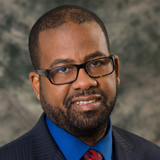 Damon Dozier
Damon Dozier
MRS Director of Government Affairs
After almost eight months of uncertainty, Congress finally passed, and the President signed, appropriations legislation that would fund the government for the rest of the current fiscal year. Action on funding the government had been delayed by a number of factors, including last year’s Presidential election, and an interest by some Members of Congress to establish new funding priorities and goals for certain agencies. Until the recent action, the government was operating under a continuing resolution or “CR” which set appropriation amounts at the FY16 level—meaning essentially that government activities were flat-funded since October 2016.
Before the Administration released an outline of its funding priorities for FY18, there had been a number of discussions expressing concern for S&T and R&D budgets for FY17. The FY18 agreement recently reached is very much in line with what House and Senate Appropriations Committees approved last year. Almost every science agency received at least moderate increases, with the notable exceptions of the National Science Foundation (NSF) and the National Institute of Standards and Technology (NIST).
The Department of Defense (DOD) is slated to receive a 7.8 percent increase in its S&T budget over its FY16 levels, with most of the increase being directed towards applied research (6 percent) and applied technology development (13 percent). On the negative side of the ledger, basic research was cut by 1.4 percent, or $33 million. This cut represents an unfortunate trend in recent years that has seen both the White House and Congressional appropriators supporting cuts for fundamental basic research within the DOD. In FY18, the Administration has announced a desire to see funding for the DOD increase by as much as $54 billion, but it is unclear at this point where these monies would be directed.
The Department of Energy (DOE) will get an overall increase of 3.5 percent, with an increase of 0.8 percent or $42 million, over the FY16 enacted level for the Office of Science. This increase is seen as a positive sign as the Office of Science would be cut by about $900 million if the Administration’s budget blueprint were to be enacted into law. Along similar lines, FY17 funding for high risk applied energy research programs (ARPA-E) will increase by 5.2 percent over FY16 enacted, but the Administration calls for complete elimination of the program in FY18. Finally, the Office of Energy Efficiency and Renewable Energy (EERE) has escaped a funding cut, which is positive news considering the Administration had requested a $516 million cut to the office for the remainder of FY17 and suggested cuts for FY18 could have run as high as $1 billion, according to a number of sources.
As far as the National Institutes of Health (NIH) is concerned, Congress approved $34 billion overall, an increase of 6.4 percent over FY16 and a sizable increase over the previous Administration’s FY17 request. Most notably for the readers of INTERSECTIONS, the National Institute of Biomedical Imaging and Bioengineering (NIBIB) would see an increase of $10 million or 3 percent. This office is focused on improving human health by providing leadership for development and accelerating the application of biomedical technologies. The current Administration has proposed a nearly 20 percent ($6 billion) cut to the NIH, but it is unsure at this juncture if and how NIBIB would be affected.
In terms of funding for NSF, Congress agreed to a small increase of $8 million, or 0.1 percent, with most of the increase going to the major research equipment and facilities construction account and not to the six Directorates that are responsible for awarding research grants. This means essentially that the grant-making authority remains the same as last year. Interestingly enough, the Administration’s initial budget blueprint makes no mention of the NSF, but additional details may be forthcoming in a more detailed exposition that is expected to be released in the coming weeks.
Finally, NIST would be cut by $10 million, or 1 percent, from FY16 enacted, with the bulk of the cuts coming from the construction of research facilities account. Notably, while the Scientific and Technical Research and Services account is flat-funded, laboratory programs under this umbrella, such as the Material Measurement Laboratory and the Physical Measurement Laboratory, would see a $3 million increase. The Administration’s budget blueprint for FY18 is also silent regarding NIST funding, with details expected to be released soon.
Grassroots Subcommittee Chair News—MRS Grassroots Advocacy
 Brent Carey
Brent Carey
Chair, Grassroots Subcommittee
Just a quick update on MRS Grassroots Advocacy activity as spring gets into full swing! Our Membership sent a total of 1,025 letters to their elected representatives at the 2017 MRS Spring Meeting in Phoenix on two important issues pertaining to current issues in S&T policy.
Given the austere budget proposal submitted by President Trump—which would have given most federal R&D funding agencies upwards of a 10+% haircut if enacted—our letters focused on promoting sustained funding for basic and applied research for the remainder of 2017, and specifically outlined the importance of energy and manufacturing programs in budgets FY18 and beyond. In a stunning reversal from the President’s proposal, the continuing resolution that was passed earlier this month includes a net 5 percent increase in federal R&D spending and major support for advanced energy programs such as ARPA-E—that would have been eliminated in the President’s proposal. This is great news for science, and a true beacon in the cloudy political environment we find ourselves in today.
This is advocacy in action. Your letters make a difference, so thanks for all of your help in communicating the importance of these issues to your elected officials!
MRS Congressional Science & Engineering Fellowship Corner
 Gavi Begtrup
Gavi Begtrup
Chair, Congressional Fellow Subcommittee
This spring the Congressional Fellows Subcommittee completed the selection process for the 2017-2018 MRS/OSA and MRS/TMS Congressional Science and Engineering Fellows from another highly competitive applicant pool. Stay tuned for a separate announcement about our new incoming Fellows, who will enter the program at the end of August starting with our traditional welcome breakfast with former MRS Congressional Fellows and a few members of the GAC.
The GAC sponsored an information session at the 2017 MRS Spring Meeting in Phoenix to provide information to potential applicants about the program. GAC Member Ashley White (2010-2011 MRS/OSA Congressional Fellow), and current MRS/OSA Congressional Fellow, Felicia Lucci, presented an overview of the program. We have held these information sessions at each spring and fall meeting consistently for a number of years, and these sessions contribute to our ongoing draw of high-quality applicants. Please direct any potential applicants, at all career stages, to these information sessions or to the MRS Fellowship web page.
Our current 2016-2017 MRS Congressional Fellows, Felicia Lucci (MRS/OSA) and Aaron Dunn (MRS/TMS), are entering the final quarter of their Fellowship year, working in the offices of Senator Heidi Heitkamp (D-ND) and Senator Gary Peters (D-MI), respectively. Stay tuned for an update as they finish their Fellowships and continue their careers.
Fall Congressional Visits Day—Science Does Not Speak for Itself

William Hammetter
Chair, Congressional Visits Day Subcommittee
On Tuesday, May 2, twenty-three MRS Members participated in the Spring Congressional Visits Day in Washington, DC. Fifty-four offices of Senators and Congressional Representatives were visited. Our initial intent was to advocate for sustained funding for fundamental scientific research in the 2017 budget. Unfortunately for us, but fortunately for science, the final appropriations bill for 2017 was announced the day we arrived in Washington. Damon Dozier, the MRS Washington representative, did a tremendous job in recrafting our “message” to advocate for the 2018 budget.
During our meetings in the different Senate/House offices, we found that the general mood on the Hill was that the 2017 bill was a “PGR” (Washington parlance for a “pretty good result”), and every office anticipated the success of the bill. The bill was subsequently passed by the House, the Senate and signed by the President that week. We learned that introduction of the President’s “Skinny Budget” prompted many visits, letters and phone calls from scientific/technical societies, universities and individuals interested in continued funding for research—that advocacy actually made-a-difference in the 2017 bipartisan budget bill. We at MRS were encouraged to continue our advocacy efforts, and possibly, even enhance our advocacy with more frequent in-district visits to develop continuing relationships with lawmakers—amplifying our voice and fostering trust in MRS.
Negotiations for the 2018 budget will be starting very soon. Science does not speak for itself. The Members of the Materials Research Society must learn to speak for science to lawmakers and to the general public. Please become an active advocate for science.
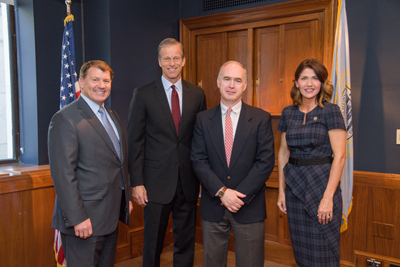
South Dakota Sunrise Coffee during the MRS Spring 2017 Congressional Visits Day.
The South Dakota delegation. From left, Senator Mike Rounds, Senator John Thune, MRS Member, Steve Smith and Congresswoman Kristi Noem
The California Washington Team at the MRS Spring 2017 Congressional Visits Day.
From left, Susan Ermer, Kevin Whittlesey and Ilke Arslan.
2017 MRS SPRING MEETING—
Conversations with Government Agency Representatives Regarding Funding in Research
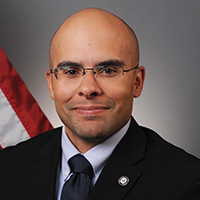
Diogenes (Dio) Placencia
Chair, Government Agency Subcommittee
Greetings! Our recent 2017 MRS Spring Meeting held in Phoenix was a special event for the Government Agency Subcommittee since we’ve acquired yet another data point on our revamped model for the Research Funding Opportunities session. As some of you may remember, we previously allowed up to 30 minutes for each presentation from program managers (PMs) and stretched these presentations across two evenings. Although this presented a good opportunity for PMs to dive into the details of their programs, it did not adequately allow enough time for Members to interact with them. Further, attendance during the second half (typically Thursday) of the presentations dropped significantly. As a result, the model for the presentations was switched to one that: 1) reduced the amount of time for PM presentations; 2) compressed the session into one evening; and, 3) allowed for significant interactions between Members and the PMs—employing the ‘Speed Dating’ model—Members interacting with PMs for 15 minutes at a time. The feedback we’ve received from the revamped model has been overwhelmingly positive! As we move forward, we will continue to improve upon the sessions by tweaking certain aspects, all in the hopes of improving the Member-to-PM experience.
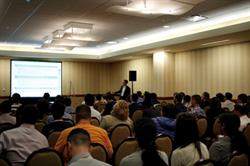 In Phoenix, there was a high MRS Member presence and rightfully so! The meeting featured a strong group of PMs from across the funding landscape. Dr. Andrew Schwartz represented the Department of Energy’s Basic Energy Sciences (DOE-BES) where he touched upon BES’ latest interests across their numerous departments. DOE’s EERE’s SunShot Program was represented by Dr. Lenny Tinker where his focus was not just on the photovoltaics piece of their portfolio, but also on other systems of interest to Members, such as Concentrated Solar Power (CSP) and Grid-relevant technologies. The Army Research Office (ARO) was represented by Dr. Pani (Chakrapani) Varanasi whose presentation focused more on the structural materials, a topic of great relevance to our Members. The National Science Foundation (NSF) was represented by Dr. Lynnette D. Madsen who provided some great insights into navigating the funding landscape at NSF and some useful programs being rolled out from the Division of Materials Research. Finally, one of the most interesting, and insightful presentations came from Dr. Thomas Rieker, who provided an overview of the William M. Keck Foundation’s process for funding research.
In Phoenix, there was a high MRS Member presence and rightfully so! The meeting featured a strong group of PMs from across the funding landscape. Dr. Andrew Schwartz represented the Department of Energy’s Basic Energy Sciences (DOE-BES) where he touched upon BES’ latest interests across their numerous departments. DOE’s EERE’s SunShot Program was represented by Dr. Lenny Tinker where his focus was not just on the photovoltaics piece of their portfolio, but also on other systems of interest to Members, such as Concentrated Solar Power (CSP) and Grid-relevant technologies. The Army Research Office (ARO) was represented by Dr. Pani (Chakrapani) Varanasi whose presentation focused more on the structural materials, a topic of great relevance to our Members. The National Science Foundation (NSF) was represented by Dr. Lynnette D. Madsen who provided some great insights into navigating the funding landscape at NSF and some useful programs being rolled out from the Division of Materials Research. Finally, one of the most interesting, and insightful presentations came from Dr. Thomas Rieker, who provided an overview of the William M. Keck Foundation’s process for funding research.
As we move forward, we recognize the diversification not only in the research being conducted by Members but also in the diversity. As this trend is only expected to grow, as a Subcommittee we are in the process of implementing a more international flavor to our Research Funding Opportunities sessions. There are many organizations that exist solely to bridge international collaborations between researchers from across the globe, and therefore, we are active in engaging them and active in increasing their participation. See you in Boston!
A Value-Added Materials Research Story—Transparent Transistors to Flat-Panel Displays to Integrated Circuits?

John F. Wager
Professor, School of Electrical Engineering and Computer Science, Oregon State University
We announced our invention of a transparent transistor in 2003. This elicited a tremendous amount of media attention. People had a hard time getting their mind around an invisible electronic switch that is made using the white cream (zinc oxide) that you lather up with in order to protect yourself from the sun when you go to the beach. I predicted that our zinc oxide transistors might be used as pixel switches in flat-panel displays. That didn’t happen. However, this story does have a happy ending.
Some background—we were exploring new materials on projects funded by the Army Research Office and the National Science Foundation. Things were not going well. We wanted to make materials that were both transparent and conductive. Most of our materials were neither. Since my group was tasked with trying to make devices, we decided to take a step backward and to build devices using more conventional materials. This led to the invention of the zinc oxide transparent transistor. Hewlett-Packard licensed this technology from OSU, and we initiated an HP-OSU collaborative research development project. Within about 6 months (this was in 2002), we discovered that we could make much better transistors if we employed semiconductors selected from a new class of materials, i.e., amorphous oxide semiconductors. We also shifted our focus away from transparency and concentrated on the development of a transistor appropriate for flat-panel display pixel switching applications. Over the next few years, we filed numerous patents and made significant progress towards improving the performance and our understanding of these transistors.
Meanwhile, in Japan, Professor Hideo Hosono and his team were exploring the use of indium gallium zinc oxide (IGZO), a specific type of amorphous oxide semiconductor, for transistor applications. It is amazing how often technology jells simultaneously across the globe. From 2003 until about 2010, many different flavors of amorphous oxide semiconductor were investigated. Then in about 2010, IGZO was informally chosen as the most promising amorphous oxide semiconductor consensus candidate for commercialization. This selection allowed flat-panel display manufacturers, tool vendors, materials suppliers, and system integration houses to co-operatively concentrate their efforts in order to move this nascent technology from the research lab to a high-volume, manufacturable product. American companies such as Apple, Applied Materials, and Corning were key players in this endeavor.
Flat-panel displays using IGZO (indium gallium zinc oxide) transistors are now a commercial reality, with HP licensing our amorphous oxide semiconductor technology to major display manufacturers. For example, my computer that I am using to write this article is an Apple iMac with 5K Retina Display. It has 14.7 million IGZO pixel switching transistors.
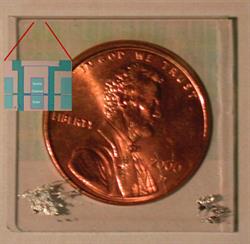
ZnO-based transparent transistors. Patterned transparent transistor test structures are evident in the upper portion of a glass substrate, which sits on a penny. Solder contacts are present near bottom corners of the glass. (Upper left insert) Enhanced -contrast, magnified image of a bottom-gate transparent transistor. The glass substrate is coated with a lower layer of indium–tin oxide (ITO), which serves as a gate, and an upper layer of aluminum–titanium oxide (ATO), which functions as the gate dielectric. Dark green regions are coated with ITO and ATO only. ITO source and drain contacts appear in tan, and a ZnO channel layer in light green.
Flat-panel displays constitute an approximately $100B per year industry. Two other technologies compete with IGZO for the flat-panel display pixel switching transistor market, amorphous hydrogenated silicon (a-Si:H) and low-temperature polysilicon (LTPS). a-Si:H has been the workhorse material since the inception of flat-panel displays about 25 years ago. Nonetheless, its performance is not adequate for many of the newer and emerging display applications. LTPS has been groomed over the last twenty years as THE a-Si:H replacement. However, with the unexpected emergence of IGZO, the a-Si:H-to-LTPS transition did not go as originally planned. Here’s the basic trade-off. LTPS has the better current drive, device stability, and circuit versatility. IGZO is cheaper, more scalable, and consumes less power. Although the jury is still out regarding whether LTPS and IGZO will consume more of the $100B flat-panel display pie, I am glad that my money is on IGZO.
Besides flat-panel displays, IGZO may emerge as an important material for use in more mainstream silicon-based integrated circuit applications. IGZO transistors have about 10 billion times less off current than silicon transistors. Also, they can be readily fabricated at relatively low temperatures over extremely large areas and with ultra-small dimensions. These attributes make them intriguing candidates for memory, image sensor, and other types of integrated circuit applications. Did I mention that the integrated circuit industry is much larger than the flat-panel display industry?
Feedback
We welcome your feedback and invite you to submit topics for consideration in future issues of this newsletter. If you have or know of stories that illustrate how an investment in materials research paid off in real dollar terms, please send your suggestions to INTERSECTIONS Editor, Len Brillson, at [email protected]. Please send your comments to [email protected].
Sign up for MRS newsletters and alerts by visiting My MRS. There you can login or create an account, and select INTERSECTIONS under Public Policy to receive this quarterly newsletter via email.
Not a current MRS member? It’s never too late to join or renew.